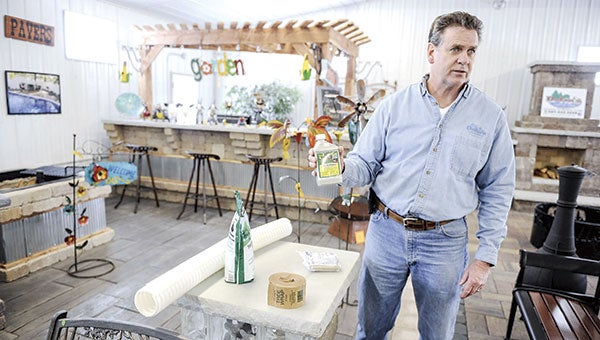Start out on the right root; Simple steps can start trees, shrubs off right
Published 9:50 am Wednesday, March 30, 2016

Brian Dolan, owner of Dolan’s Landscape Center shows off products people can use to protect their trees after planting.
Eric Johnson/Austin Living
Spring is a good time to get roots in the ground for all types of plants, especially for trees and shrubs.
Though many people like to grab a shovel and get a plant in the ground right away, several easy steps can help ensure these trees and shrubs bring a variety of color to a yard for many years to come.
Dolan’s Landscape Center owner Brian Dolan and his staff offered several tips for successful plantings:
A variety of color
The onset of emerald ash borer across Minnesota has led many planting experts to promote the benefits of diverse tree plantings — too many of the same tree can lead to problems. But diversity can also bring a full slate of colors to a home and yard.
Maples seem to be the most popular to plant in springtime because of their autumn colors, according to Dolan.
Maples come in many varieties that will have different colored leaves. For instance, an emerald queen Norway maple will emerge green and turn to yellow versus a fall fiesta sugar maple that will have golden to red-orange leaves.
“We try to push more variety than just the maples, so it’s not a monoculture across the city, across the area or in your yard,” Dolan said. “It’s very important that you get a variety.”
Shrubs are popular for their bloom color rather than the actual foliage color. They come in a range of colors from red to yellow to purple and everything in between. Hydrangea and spirea are popular for their low maintenance, which is another key characteristic people look for when planning their yard for full bloom.
“Everybody wants color and low maintenance,” Dolan said.
When to plant
Once spring officially arrives, it’s important to make sure the frost is gone and the ground is warming up before you plant. One of the best possible times to put trees and shrubs in the ground is bare root season. That’s considered the time after the ground is unfrozen and before other plants start to bud out.
“It used to be if you didn’t get your trees and shrubs planted during bare root season, then you couldn’t do anything until fall or next spring,” Dolan said.
However, in today’s garden world, many trees and shrubs start in a field or containers, so they’re available all the year and there’s no real time restriction. Still, the sooner you get it done, the longer the growing season you’re going to get, Dolan added.
How to plant
Planting involves a bit more than just digging a hole in the ground.
Make sure you don’t dig into underground cables. The size of the hole also needs to be one and a half times as wide and deep as the plant that’s in the pot or the root ball, even if you have to fill the hole back in. Don’t make the hole a perfect circle, make the edges irregular so when new roots come out, they will spread out more and won’t get tangled in a root bound pattern. It’s also important to loosen the root ball a little bit.
Place the tree in the hole, making sure the tree is straight. Fill in the hole halfway up the root ball and cut and remove the visible portions of the burlap carefully, without disturbing the root ball.
Finish filling the hole to the top of the first woody root. Water the entire area and layer about two to four inches of mulch over the area, but don’t push the mulch right up to the trunk’s root flare, the area at the base of the tree where the roots enter the soil, or else you will smother the tree’s airway.

This story appeared in the March-April edition of Austin Living. Pick up a copy at The Herald, 310 Second St. NE.
Shrubs are planted relatively the same way, though you have to be mindful of different plants, because each plant wants or needs different soils, amount of sunlight and water, added Eric Farrand, who works in the tree orchard and garden center at the nursery.
“There’s different things they want, different soil types too, depending on what you’re planning,” Farrand said. “Something that likes it dry, you don’t want to put it in a wet area of your yard.”
It’s also important to make sure the soil is good for growing. Potting soil can be mixed into the existing native soil just to give it a little boost come growing time, according to Josh Kern, a designer and estimator.
Do’s and Don’ts
Watering your plants is key, said Jennifer Mudra, who works in the garden center.
The amount of water your tree or shrub will need varies based on the type. Some plants enjoy a wet soil, while others like it more dry. In this case, it’s important to keep an eye on the temperature. If it’s a 90-degree day, the soil will dry up much faster than a 70-degree day.
Trees and shrubs usually establish themselves two to three weeks after planting, but some might take a whole month for the plants to start regulating themselves.
Plants can also be fertilized through spring and summer up until the middle of August, Mudra added.
“You don’t want to fertilize it after about the middle of August because you want the plant to go into dormant state so it will survive the winter,” Mudra said.
Another important factor for successfully growing a healthy tree is sunlight. A plant that needs a lot of sunlight won’t do well on the north side of a building, Mudra said.
If you’re not sure where to plant a particular shrub or tree, your local garden center can help.
How to save a tree or shrub
If it seems like you have taken care of the plant according to the above instructions and it’s still not doing well, it could be an insect, disease or site problem. And if that’s the case, it’s best to photograph the plant and take it into a garden center to see what can be done. Newer plants can be moved around because their root system isn’t fully established into the ground yet.
Emerald Ash Borer, a threat to Mower County?
Emerald ash borer is a nonnative invasive species that is dangerous to ash trees. It’s commonly identified by heavy woodpecker activity, dead branches at the top, sprouts around the base of the tree, vertical cracks in the bark, S-shaped tunnels under the bark and 1/8 inch D-shaped exit holes in the bark, according to the Minnesota Department of Natural Resources website.
Gary Johnson from the University of Minnesota Extension office said the disease is not yet in Mower County, but it’s closing in on many nearby counties. Southeastern Minnesota counties, the Twin Cities and Duluth have confirmed the borer’s is presence and are under quarantine, meaning firewood should not be transported and you should burn it where you buy it. It’s also present just over the border in Iowa.





